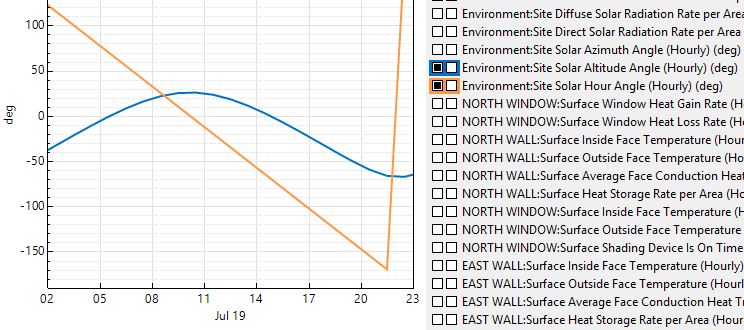why is max. solar altitude not at midday
With reference to this earlier question https://unmethours.com/question/4885/... I have a simple EnergyPlus 8.9 model with
- Building North Axis = 0
- Output:Variable,*,Site Solar Hour Angle,hourly
- Output:Variable,*,Site Solar Altitude Angle,hourly
- Latitude -42 (south)
Why when the E+ CSV file is viewed with DView is the maximum solar altitude at 10:00 instead of midday 12:00? The Solar Hour Angle also passes through 0 degrees at 10:00.
 As a consequence the Direct Solar Radiation Rate is shifted to begin 05:00, finish 14:00 rather be centered over midday. I have tried a number of E+ US weather files in combination with a number of E+ examples & they all appear to have the same issue. This means sunshine is going to be biased towards morning facing surfaces & biased away from afternoon facing surfaces.
As a consequence the Direct Solar Radiation Rate is shifted to begin 05:00, finish 14:00 rather be centered over midday. I have tried a number of E+ US weather files in combination with a number of E+ examples & they all appear to have the same issue. This means sunshine is going to be biased towards morning facing surfaces & biased away from afternoon facing surfaces.
Thanks for any help.
24/4/2018 update After a day hacking away at DView C++ code I've finally gotten to the bottom of this hole I dug for myself. Some issues are my misunderstanding, but one is a bug in DView code. My main discoveries:
- Although E+ creates a CSV file with its 1st column being a date/time every hour, DView completely ignores these values. DView ALWAYS starts its X axis at 1/1/0000 midnight with a 1 hour time increment. This is my misunderstanding. So if I have a CSV file for a single mid winter day, it won't have the correct date/ times on the X axis.
- I believe there is a DView bug in which the 1st row from the E+ CSV is ignored. It reads (& discards) the date/time cell, but forgets the other cells on the 1st row. I have fixed this bug (it now reads the date but still ignores the time because E+ always works with a full 24 hour day) but it may cause problems for other use-cases. This explains a 1 hour timeshift on any DView graph.
- E+ often has NULL (or empty) cells in its output CSV file. DView will display a messagebox for each & every NULL value. For an annual simulation that may mean 365+ message boxes. I've changed the code to only display the messagebox once, it now displays the line number, but then no further messageboxes.
- the "debug" version of DView crashes if you close/ open other files, and at exit, but users of the "release" version will be blissfully unaware of dangling C++ pointers & other nasty stuff
Copy the text below into a CSV file using a plain ASCII editor like Notepad:
Date/Time,col2,col3
07/21 01:00:00,11,50
07/21 02:00:00,12,51
07/21 03:00:00,13,52
07/21 04:00:00,14,53
07/21 05:00:00,15,54
07/21 06:00:00,16,55
07/21 07:00:00,17,56
07/21 08:00:00,18,57
07/21 09:00:00,19 ...



